
2007 4th Issue
Feature Articles
I. Food Safety Day 2007
Eric SUEN, our Food Safety Ambassador, pays attention to the hygienic condition of a restaurant whenever he eats out. In his view, food premises in Hong Kong do achieve a high hygiene standard.


The favourite foods of our second Food Safety Ambassador, Candy LO, are sashimi and sushi. Since these are higher risk foods, she will be very cautious in ensuring food safety.
This summer, the Centre for Food Safety (CFS) and Radio One of the Radio Television Hong Kong (RTHK) jointly organised the "Food Safety Day 2007". A number of celebrities and pop singers were invited to share views on food safety. Both artists Eric Suen and Candy LO were Food Safety Ambassadors of this event.

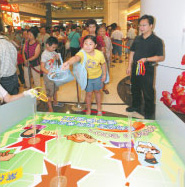
The "Food Safety Day 2007", entitled "Collective Responsibility in Ensuring Food Safety", was held on 18 August at Lung Cheung Mall in Wong Tai Sin, with RTHK DJs SIU Kwok-wah, CHOI Ho-leung and CHEUNG Yuen-kwan as the masters of ceremonies. Invited to the event were Dr York CHOW, Secretary for Food and Health, Mr Eddy CHAN, Director of Food and Environmental Hygiene, Dr Constance CHAN, Acting Controller of CFS, Mr Phillip CHOW, Acting Assistant Director of Broadcasting (Radio), Hon Fred LI, Deputy Chairman of the Legislative Council Panel on Food Safety and Environmental Hygiene as well as representatives of the food trade and members of the public. CFS has organised the Food Safety Day for the second time. Speaking at the opening of the event, Dr CHOW said that since its establishment in 2006, the CFS had spared no efforts in communicating with the food trade and the public to listen to their views. He urged the food trade to comply with the laws and regulations and source foods that were safe for consumption, while members of the public should observe good food hygiene and purchase foods from reliable retailers.
The "Food Safety Day 2007" kicked off with guests of honour officiated at the opening ceremony. Food Safety Ambassadors, Eric SUEN and Candy LO, together with other singers and bands, joined the audience in the games "Food Safety Responsibility", "Critical Control Point CCP" and "Check the Labels" to disseminate food safety messages. The game booths and exhibition attracted active participation from the public who could learn more about the roles played by the Government, the trade and the public in promoting food safety.
II. Collective Responsibility in Ensuring Food Safety

To ensure food safety, an active tripartite collaboration among the Government, food trade and public is essential. "You" have a significant role to play.
Role of the Food Trade
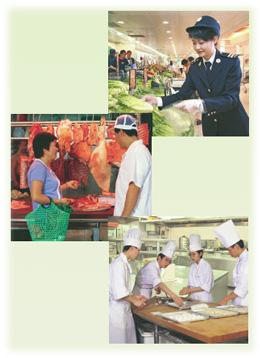
- At source and in production,
- Source food and ingredients from reliable sources
- Comply with good manufacturing practice
- Comply with good manufacturing practice
- Pay close attention to food-related information released by the CFS and the latest development of food legislation
- Comply with requirements of food legislation
- Make sure the food on sale is safe and hygienic
The Government will make strenuous efforts to develop and implement effective food safety measures and to maintain close liaison with food authorities abroad. Whereas the public should observe good personal and food hygiene and purchase food from reliable retailers.
III. EatSmart Restaurants Spell Business Opportunities
"I'll have a Caesar salad with low fat cheese and sauce on the side, roasted skinned chicken in rosemary and garlic sauce, iced coffee with skimmed milk and syrup on the side. Lastly, a fresh fruit platter with no added syrup as dessert. Thanks!"
A healthier meal on demand! Is there any way we can make healthy eating easier?
What if restaurants volunteer to prepare an array of ready-to-go-healthier dishes for your choice?
From time to time, CFS organizes food hygiene promotion programmes with other organisations. In August, more than 300 food premises took part in the EatSmart@restaurant.hk Campaign Pilot Project organised by the Department of Health (DH). In a month's time, more than 500 refreshing and healthy recipes were offered. Customers and operators of restaurants welcomed this healthy eating campaign. CFS, of course, supports this health promotion campaign and would like to see it extended to the whole territory.
Nutrition Criteria
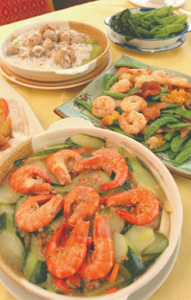
All restaurants can prepare healthier dishes at ease by referring to the "Guide Book for Restaurant Managers" and "Guide Book for Chefs" published by DH. All they need are some creativity and include more fresh ingredients.
Participating restaurants shall make reference to DH's Guide Books to provide some healthier dishes of two kinds -
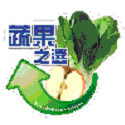 Dish with More Fruit and Vegetables
Dish with More Fruit and Vegetables
means that either fruit and vegetables are the sole ingredients of the dish, or they occupy at least twice as much the amount of meat in the dish
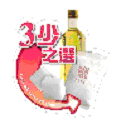 3 Less Dish
3 Less Dish
means that the dish has less fat or oil, salt and sugar, meeting the '3 less' requirement
Enrolment Criteria
Any restaurant or canteen with a food licence from FEHD can nominate two to four staff to participate in the first round of Training Session held between December 2007 and January 2008. Restaurants will be named EatSmart Restaurant when they commit to providing at least five healthier dishes of "More Fruit and Vegetables" and "3 Less" dishes on its regular menu, and ensure correct labelling of such dishes to facilitate customers' selection. EatSmart Restaurants, while enjoying free marketing through DH's territory-wide promotion programmes, will build up an image as being customer-oriented and caring for customers' health. To promote food hygiene, restaurants are encouraged to participate in this campaign. Details are available in the Campaign's thematic website www.eatsmart.gov.hk. Interested parties may also contact the Central Health Education Unit of DH (tel: 25271476) for inquiries.
Readers' Corner
I. Preservatives in Food
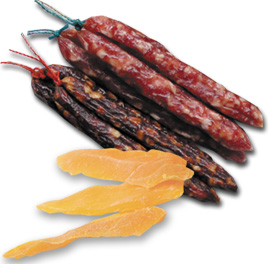
Food may deteriorate if not properly stored. Besides spoiling many desirable properties (e.g. taste, colour and nutrition) of food, micro-organisms may grow and produce toxic substances which cause harmful health effects.
Preserving techniques have been in use since ancient times to extend the shelf life of food. A number of food preserving methods have been invented, including air-drying, smoking, salting/pickling and the use of preservatives. However, improper use of preservatives will render the food unfit for human consumption.
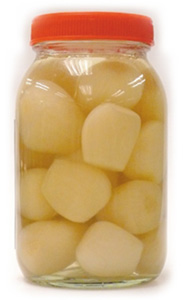
The use of preservatives has already been included under the routine food surveillance programme of the CFS. Recently, the CFS conducted a targeted food surveillance project to assess the use of preservatives (including sulphur dioxide, benzoic acid and sorbic acid) in preserved fruits and vegetables, and the results were published on 27 September. Among the more than 460 samples tested, 40 (or about 9% of the total number of samples) were found to be unsatisfactory. Most of the unsatisfactory samples contained an excessive level of preservatives (including sulphur dioxide, benzoic acid and sorbic acid), while only a very small number of them involved the use of unpermitted preservatives in the food concerned. Sulphur dioxide, benzoic acid and sorbic acid are commonly used preservatives of low toxicity. They should not pose significant health risks to consumers upon normal consumption.
The CFS has taken follow-up actions, including tracing the source of the food in question, asking the vendors concerned to stop selling and to dispose of those food items, taking follow-up samples and issuing warning letters. If there is sufficient evidence, prosecution action will also be taken. The CFS has also urged the food trade to comply with legal requirements when using preservatives.
Advice to the Trade
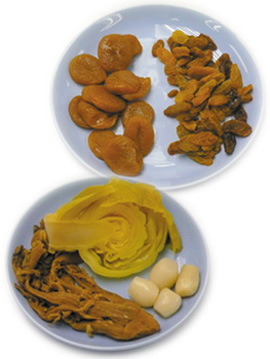
- Comply with legal requirements and choose suitable preservatives according to food groups.
- Preservatives in Food Regulations (Cap. 132BD) are currently under review with a view to reflecting the latest development in food science and technology. For information about the progress of legislative review, please visit our website http://www.cfs.gov.hk.
- Follow the good manufacturing practice by limiting the quantity of the preservative added to food to the lowest possible level necessary to accomplish its desired effect.
- Source food and ingredients from reliable sources.

II. Regulation of Red 2G
Red 2G (also known as CI Food Red 10, International Numbering System No. 128) is a synthetic colour that is resistant to light, heat, acid and sulphur dioxide. According to the Colouring Matter in Food Regulations, Subsidiary Legislation H of the Public Health and Municipal Services Ordinance (Cap. 132), Red 2G is a permitted colouring matter to be used on food.
Recently, the European Food Safety Authority re-evaluated the safety of Red 2G and concluded that Red 2G is of food safety concern. The European Commission has therefore, on 26 July 2007, legislated to suspend the use of Red 2G on food.
Given the latest results of scientific studies and recommendations of the Expert Committee on Food Safety, CFS will amend the Colouring Matter in Food Regulations by removing Red 2G from the list of permitted colouring matter.
Advice to the Trade
- Stop using Red 2G and colouring matter containing Red 2G on food as soon as possible.
- Change the formulation by removing Red 2G and colouring matter containing Red 2G and replacing them with permitted colouring matter such as Erythrosine, Ponceau 4R, Amaranth, Allura Red AC or other permitted natural colouring matter.
III. Pesticide Residues in Food
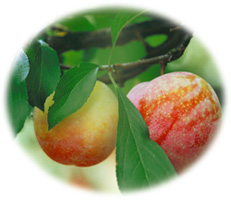
What are pesticides?
Pesticides are substances used to kill or control unwanted insects, plants, fungi, rodents or other pests. Insecticides, herbicides, rodenticides and fungicides are some commonly used pesticides.
Why are pesticides used?
Pesticides kill or control pests and hence reduce food loss resulted from infestation, increase food supply and cut back food production cost. Comparing with other pest control methods, the application of pesticides is more efficient and cost-effective.
Why do pesticides appear in food?
The presence of pesticide residues in food may be resulted from:
- direct use of pesticides on crops;
- animal feeding on pesticide treated feed; or
- environmental contamination.
Why is regulation of pesticide residues in food required?
Excessive exposure to some pesticides may cause adverse health effects. Regarding the regulation of pesticide residues in food in Hong Kong upon the application of pesticides, the Public Health and Municipal Services Ordinance (Cap. 132) stipulates that all food on sale must be wholesome, unadulterated and fit for human consumption. However, there is no specific subsidiary legislation to govern pesticide residues in food in Hong Kong.
Proposed Regulatory Framework
To better protect public health, facilitate effective regulatory control and promote harmonisation between local and international standards, the Government has proposed to introduce a new subsidiary legislation to govern pesticide residues in food.
The proposed regulatory framework mainly includes demarcating the scope of regulatory control of "pesticides"; specifying clearly the allowed concentration of a pesticide residue in food; adopting the standards established by the Codex Alimentarius Commission as the backbone to develop the standards for Hong Kong and the criteria with regard to contravention.
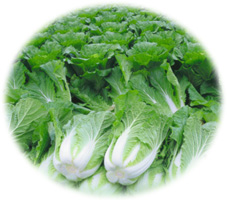
Views Sought
Public consultation has begun on 13 November 2007. The consultation document can be downloaded from CFS website (http://www.cfs.gov.hk) or obtained from the following locations:
- CFS Communication Resource Unit
8/F, Fa Yuen Street Municipal Services Building,
123A Fa Yuen Street, Mongkok, Kowloon - FEHD District Environmental Hygiene Offices
- District Offices of the Home Affairs Department
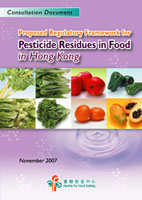
Views of the public and the trade on the proposed regulatory framework are very important. Please send your comments by letter, facsimile or e-mail to CFS before 31 January 2008:
Centre for Food Safety
(Attn.: Risk Assessment Section)
Food and Environmental Hygiene Department
43/F, Queensway Government Offices,
66 Queensway, Hong Kong
Facsimile: (852) 2893 3547
E-mail address: pesticide_consultation@fehd.gov.hk
Enquiry telephone no.: (852) 2867 5699
Any person submitting views and comments should be aware that the Government may publish all or part of the views and comments received and disclose the identity of the source in such manner as the Government considers appropriate, unless he/she requests any part of the views and comments and/or his/her identity be treated in confidence.
Food Safety Plan Corner
Hazard Analysis and Critical Control Point (HACCP) — Roast Chicken
Critical Control Point of Preparing Roast Chicken
Christmas is approaching! Many schools and organisations will hold parties to celebrate this festive season. Roast chicken is one of the most popular items on the Christmas menu.
Roast chicken recipes are usually simple. However, as the entire chicken is put into the oven for roasting, the critical control point is to make sure that each and every part of the meat is thoroughly cooked. Let's take a look at the production of "honey-roasted spring chicken":
Honey-roasted Spring Chicken
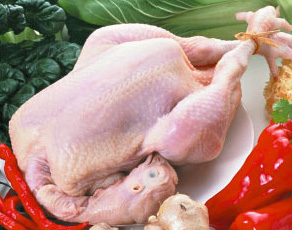
| Ingredients | |
|---|---|
| Spring Chicken ........ | 2 [approximately 675 g/1.5 lbs] |
| Barbecue Pork Sauce ..... | 3 tbs. |
| Seafood Sauce ........ | 2 tbs. |
| Sesame Oil ........ | 1 tbs. |
| Herbs ................... | 1 tsp. |
| Honey ................... | 2 tbs. |
Production Process
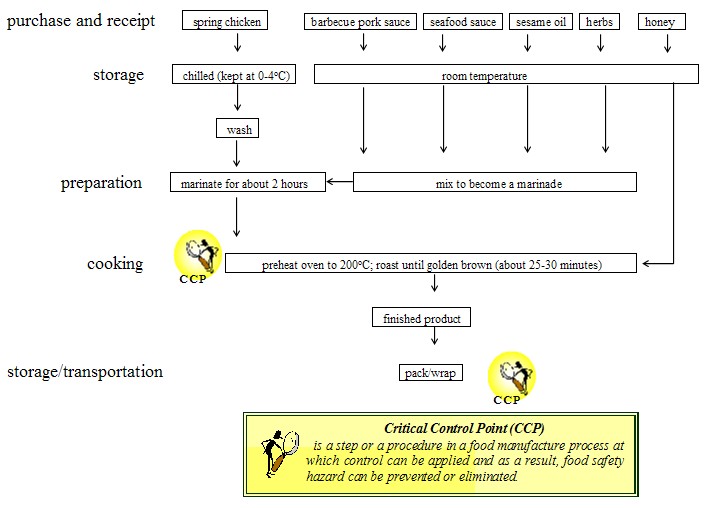
Guidelines on Roast Chicken Production
- Purchase and receipt
- Purchase ingredients from licensed and hygienic suppliers.
- Check that the ingredients are not contaminated or damaged and have not passed the "expiry" or "best before" date.
- Storage
- Store the ingredients immediately at proper temperature.
- Keep raw poultry meat in covered containers and store in the lower compartment of the refrigerator. Keep ready-to-eat and cooked food in the upper compartment to avoid cross-contamination.
- Practise first-in-first out stock rotation method.
- Preparation/Cooking
- Wash thoroughly all table surfaces, utensils and equipment that have been used for preparing poultry meat.
 Poultry meat has to be marinated for a longer time (approximately 2 hours) and should therefore be refrigerated when left to marinade.
Poultry meat has to be marinated for a longer time (approximately 2 hours) and should therefore be refrigerated when left to marinade.- Preheat the oven to a suitable temperature before roasting.
- Cook poultry meat thoroughly before consumption. Continue cooking for at least two more minutes after the core temperature of the meat reaches 70 ℃. (CCP)
 If there are pinkish juices running from the cooked poultry or if the middle parts of the bones are still red, cook the poultry again until fully done.
If there are pinkish juices running from the cooked poultry or if the middle parts of the bones are still red, cook the poultry again until fully done.
- Storage/Transportation
- Store the food immediately at 60 ℃ or above. Avoid leaving the food at room temperature for more than two hours. (CCP)
- Management System
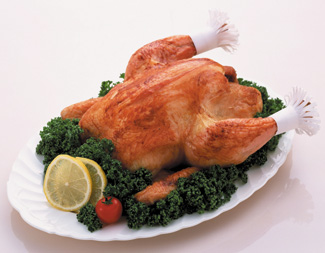
Adopt a preventive food safety management system (e.g. HACCP System) to identify and control food safety problems during food production.
Food News
Understanding Cholesterol
Many people associate "cholesterol" with something disadvantageous to health. In fact, cholesterol is mainly used for cell membranes synthesis and production of bile and certain hormones. An appropriate amount of cholesterol is required to maintain good health. Excessive cholesterol in blood may, however, accumulate on the inner walls of our blood vessels and increase the risk of heart disease and stroke. The following questions and answers may tell you more about cholesterol.
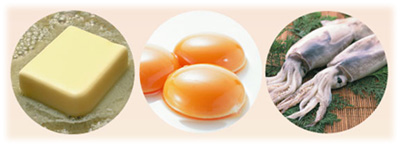
Q1: Does all cholesterol in our blood come from our diet?
A1: No. Only a small amount of our blood cholesterol comes directly from food. Most of it is produced by our liver and some other parts of our body. High cholesterol foods include egg yolks, viscera, squids, cuttlefish, lards and animal fats. Excessive consumption of high fat foods (particularly those containing saturated fats and trans fats) and high cholesterol foods will raise the total cholesterol level in blood.

Q2: Are there "good" cholesterol and "bad" cholesterol?
A2: Yes. Low-density lipoprotein cholesterol in our body is known as "bad" cholesterol. The higher the concentration of "bad" cholesterol in blood, the greater the risk of heart disease and stroke. On the contrary, high-density lipoprotein cholesterol is "good" cholesterol that helps to prevent heart disease. Saturated fats, trans fats and cholesterol in our diet raise the level of "bad" cholesterol in our blood; whereas a high fibre diet (particularly water-soluble fibre) helps to reduce "bad" cholesterol and regular exercise helps to increase "good" cholesterol in our blood.

Q3: Is it true that only fat people have the problem of high cholesterol level?
A3: No. High cholesterol level is not exclusive to overweight or fat people. It can be attributed to heredity or other factors. A balanced diet, healthy lifestyle and regular exercise are what everyone needs to stay mentally and physically healthy.
Activities
(I) Food Safety Seminar for Trade 2007

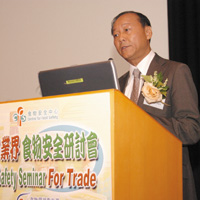
The Food Safety Seminar for Trade 2007 was successfully held on 12 September 2007 at the Lecture Theatre of the Hong Kong Central Library with 220 participants. Following the opening address by Mr Eddy CHAN, Director of Food and Environmental Hygiene, medical doctors and scientific officers of CFS talked on various hot issues, including Update on the Proposed Labelling Scheme on Nutrition Information, Voluntary Labelling System for Genetically Modified Food, Latest Labelling Requirements on Food Allergens and Food Additives, Proposed Regulation of Pesticide Residues in Food, Microbiological Guidelines for Ready-to-eat Food, Pre-statutory Voluntary Enrolment Scheme for Food Importers and Distributors, and Licensing Regime for Food Businesses. The seminar provided a forum for interactive exchange of information and views between the Government and food trade.
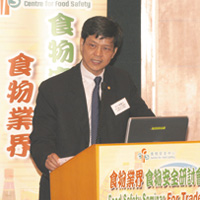
The objective of the seminar was to facilitate the understanding of major safety principles in food production by the trade, and to ensure that foods sold in Hong Kong are safe and fit for consumption through tripartite collaboration among the Government, the food trade and the consumers.
(II) Trade Briefing on Guidelines on Identification and Labelling of Oilfish/Cod
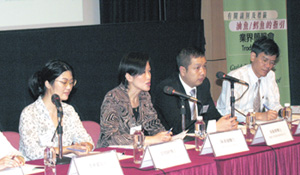
In light of complaints lodged by members of the public about oily diarrhoea after consuming fish believed to be "oilfish" but labelled as "codfish", a working group comprising representatives from CFS, the trade, academic institutes, the Consumer Council and the Agriculture, Fisheries and Conservation Department was formed to draw up guidelines on identification and labelling of oilfish/cod.
CFS issued the Guidelines on Identification and Labelling of Oilfish/Cod on 16 August 2007. Elaborating on the guidelines during the trade briefing, the Acting Controller of CFS, Dr Constance Chan, said that as each fish species had only one valid scientific name, which was unique and universally recognised, fish traders should use scientific names in their transactions to avoid confusion.
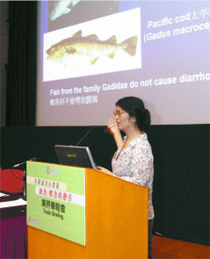
The guidelines have taken into account the requirements of a number of countries on naming, labelling and handling of fish which might cause oily diarrhoea. For oilfish, the scientific names of the two species most commonly reported to be associated with oily diarrhoea are Ruvettus pretiosus and Lepidocybium flavobrunneum. To help consumers, the working group recommends that these fish species should be labelled "oilfish" in English and"蠟油魚"in Chinese as their common names, and no other names, including "cod", should be used. The Government will monitor the situation and review the guidelines in consultation with the fish trade and other relevant parties as appropriate
Advice to the Trade
- Members of the trade, including importers, wholesalers, retailers and restaurant operators are advised to adopt the guidelines to avoid confusion and to enhance consumer confidence.
- The trade are required by law to properly describe their food products.
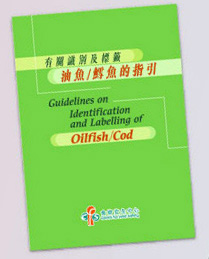
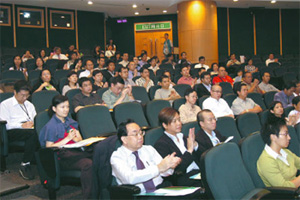
(III) Food Hygiene Seminars

Under the Food Hygiene Campaign, CFS conducted a series of 22 sessions of food hygiene seminars from June to September 2007. Under the theme "Let's work together for better food safety", these seminars aimed at publicising proper food handling measures to employees of food business, staff of elderly centres and child care centres, teachers and members of the public. They also promoted the adoption of the "HACCP" System and the implementation of a "Food Safety Plan" in food processing to enhance food safety. Emphasis was also placed on the importance of active participation and tripartite collaboration among the Government, the food trade and the public.
CFS wishes you a prosperous and successful year to come.